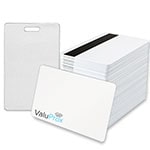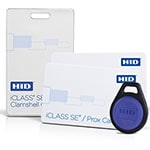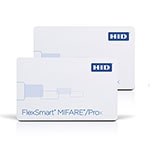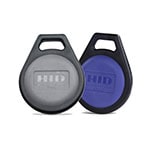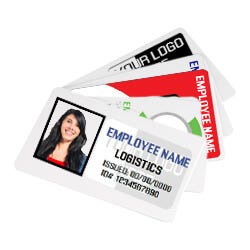We use cookies and similar technologies on our website to enable some essential functions for you. Learn more.
Proximity & Access Control ID Cards
Proximity Cards or Prox Cards provide wireless access to unlocked doors, replacing the traditional key and lock. Prox cards work with access control systems to grant or restrict access to buildings or secured areas. At ID Wholesaler we offer best-value proximity cards, access key tags and fobs, and smart cards. Shop our large inventory of proximity and access control cards below.
Shop Prox & Access Control Cards by Category
VALUPROX
Proximity ID Cards
✓ Faster order fulfillment
✓ Significant cost savings up to 23%!
✓ Superior quality control
Shop Prox & Access Cards by Brand
Expert Tips & Advice
In addition to the security industry, access control maintains its constant growth among many organizations around the globe. This includes our customers! The majority of them are using some type of proximity card or MIFARE card for access control, ticketing, toll, time & attendance, and other applications.
However, it’s easy to confuse a proximity card with a MIFARE card. Here are the basic differences between the two technology card options:
Proximity Cards
The microchip embedded within a proximity card has only one function: to provide the prox card reader with the card’s identification number and/or site facility code number so it can be verified with a remote computer.
Many access control systems only read the identification numbers and do not require the available memory that is present in a smart card. Prox cards – such as the HID 1386 prox card – are commonly used for door access.
MIFARE Cards
A bit of history: MIFARE cards and card readers were originally developed to handle payment transactions for public transportation systems in Europe.
Today, MIFARE cards can provide identification, authentication, and store information on the card because of the microchip and memory which is embedded within the MIFARE card. These cards are very durable and designed to keep your sensitive information safe. Encryption keys prevent data from being emitted until the MIFARE card and card reader mutually authenticate each other.
It’s also an RFID card because of its frequency of 13.56 MHz. MIFARE cards have three main differences from a standard proximity card:
- The frequency of a MIFARE card is 13.56 MHz. A standard 1386 proximity card is 125kHz.
- The standard MIFARE card is factory programmed with a unique 32-bit serial number. This is a random number and does not contain a facility code. Most 26-bit proximity cards use a facility code within their configurations.
- A MIFARE card has memory for storing values (typically up to 1 kilobyte of data). A proximity card does not have the capacity to store values.
A MIFARE card can be programmed with multiple credentials, which adds an extra “handshake” between the card reader and the card reader software. The memory within the MIFARE card can also be programmed for use as a cash card or a pre-paid membership card.
RFID Readers & Prox Card Readers
It’s important to make sure your cards readers can “read” technology cards that are 13.56 MHz; your readers may only be able to read the 125kHz frequency. Also, MIFARE cards come pre-encoded with a unique 32-bit number, so you will need to make sure your software can read 32-bit formats.
We understand that choosing the right technology card for your application can be confusing and somewhat complicated. Whether you need a proximity card or MIFARE card for your organization, there’s no need to stress out over it. ID Wholesaler has you covered! Our friendly, knowledgeable ID Professionals are happy to help. Call today at (800) 321-4405!
+ Read more
Proximity cards have an integrated circuit that is attached to an antenna and then sandwiched between plastic. They use RFID (radio frequency identification) which is a wireless technology for communication between electronic devices. Within the ID card industry, this technology enables a contactless smart card to "talk to" or communicate with a card reader. When properly handled, proximity cards are a reliable access entry device. There are three primary reasons you may experience proximity card failure:
- Breaking the bond between the chip and antenna. This can occur through abnormal wear and tear on the card in the area of the chip. This is most often caused by using the card for something other than what it was intended.
- Exposing the card to electrostatic discharge (ESD). Proximity cards have an integrated circuit within the plastic which can be wiped out by static electricity.
- Exposing the cards to extreme magnetic fields. Magnetic fields can wipe out a chip's programming, rendering it unusable.
If any of these has taken place, the proximity card will need to be replaced. To avoid future issues, it's important to know that the proper handling and storage of proximity cards is critical to the life of the card.
A smart, affordable, and simple way to ensure the safety and longevity of your prox cards is by using a badge holder specially designed for these types of technology cards.
Proximity card holders are made of long-lasting materials to protect your prox cards from daily wear and tear. They also help prolong the life of prox cards which saves money in the long run. We offer a variety of styles, including:
- Heavy-duty vinyl
- Plastic
- Polycarbonate
- Vinyl
They're offered in horizontal and vertical orientations, in packs of 100 or packs of 50.
 To make your ID card program even more economical, try ValuProx Proximity Cards! Equivalent to other 1386 and 1336 prox cards, ValuProx cards deliver branded proximity card performance at value pricing.
To make your ID card program even more economical, try ValuProx Proximity Cards! Equivalent to other 1386 and 1336 prox cards, ValuProx cards deliver branded proximity card performance at value pricing.
Available in standard 26-bit formatting with 125 kHz access control technology, ValuProx cards offer reliable card reads and are universally compatible with 125 kHz proximity card readers. The cards feature horizontal and vertical slot punch indicators on the back to prevent internal coil damage when using a slot punch.
No matter what your proximity card question or quandary may be, you can rely on the vast expertise of our ID Professionals. Call us today at (800) 321-4405!
Before designing your ID cards, it’s important to list the information that will be placed on the card. The design of the card should revolve around this data. It may be obvious to place the employee photo and name on an ID badge, but what other information should you consider?
ID CARD CONTENT IDEAS
Here is a list of ideas to get you thinking about what information could be on the front or back of your ID cards:
- Company Logo
- Company Contact Info
- Cardholder Name
- Cardholder Photo
- Cardholder Signature
- Cardholder Fingerprint
- Cardholder Title (such as student, priority member, or sales director)
- Employee, Student, or Customer ID Number
- Issue and/or Expiration Date
- Barcode
- HoloMark Seal (or other visual identification marker)
- Security Access Level
- Identifying Info (such as height, weight, eye color, and sex)
- How to Return a Lost Card
- How to Replace a Lost Card
- Disclaimer and Property Information
- Cardholder Responsibilities
More content or data isn’t always better. A cluttered card is not easy to authenticate. Do not put “extra” information on the card just to fill space.
Also, you should consider security issues. Should a card become lost or stolen, make sure that there isn’t any information on the card that could jeopardize your company’s security.



